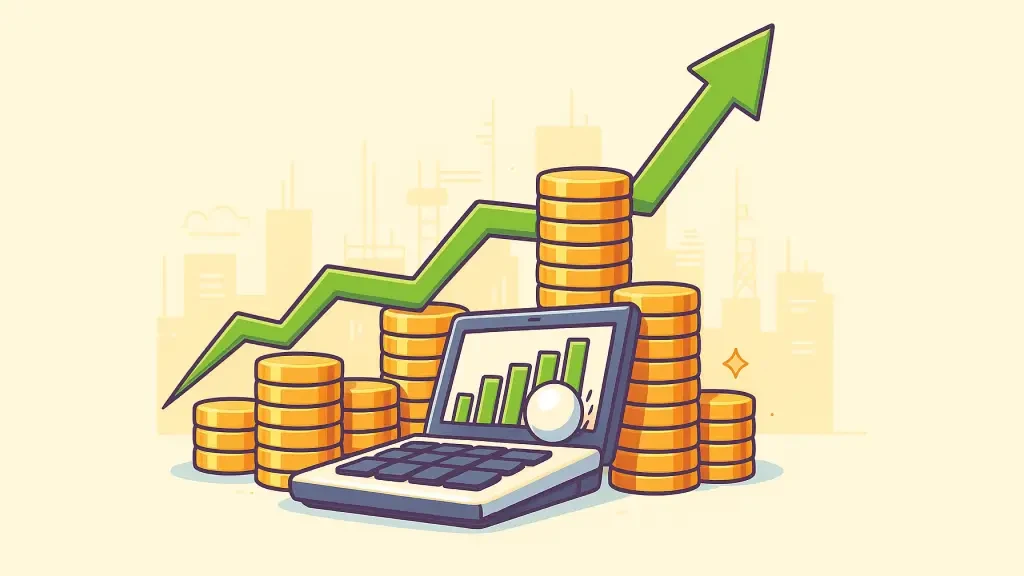Using a Dividend Growth Rate Calculator
Master the dividend growth rate calculator to analyze stocks. This guide shows you how to find data, interpret results, and grow your portfolio.

A dividend growth rate calculator is a handy tool for figuring out the annualized speed at which a company's dividend has been increasing over time. This single metric gives you a powerful glimpse into a company's financial health and its commitment to rewarding shareholders, making it indispensable for any long-term investor.
Why Dividend Growth Rate Matters for Your Portfolio

Before you start plugging numbers into a calculator, it’s worth taking a step back to understand why this metric is so important. The dividend growth rate (DGR) is more than just a number; it’s a story about a company's stability and its trajectory. Honestly, a consistently growing dividend often tells you more than a high but flat one.
Think of it like this: a high dividend yield might grab your attention, but if that payout stays the same year after year, inflation is quietly eating away at your real returns. A healthy DGR, on the other hand, means your income stream isn't just surviving—it's growing. Over time, that growth can outpace inflation and seriously boost your total return.
The Story Behind the Numbers
A strong, consistent DGR is almost always a sign of a well-managed business with a solid competitive edge. Companies that can afford to raise their dividends consistently usually have a few things in common:
- Growing Earnings: It's simple math. You can't give out more money if you aren't making more. A rising dividend is a direct reflection of growing profits.
- Confident Management: When a board approves a dividend hike, they're sending a clear signal. They're confident in the company's ability to perform well in the future.
- Shareholder-Friendly Policies: This shows a real commitment to returning capital to investors, which is a classic sign of a mature and stable operation.
This is precisely why DGR is a crucial piece of the puzzle when you're figuring out how to choose dividend stocks for a resilient portfolio.
At its core, dividend growth rate is a measure of momentum. It tells you a company isn't just surviving; it's thriving and sharing that success directly with you.
Breaking Down the Math
The basic formula for calculating DGR might look a little intimidating at first, but it’s straightforward. It finds the compound annual growth rate of the dividends over a specific period.
Let's walk through the components of the formula: ((Ending Dividend / Beginning Dividend) ^ (1 / Number of Years)) – 1.
This table breaks down each piece to make it crystal clear.
Using the example values above, if a stock paid $2.00 per share five years ago and pays $3.00 now, its DGR comes out to roughly 8.45% per year. That's the kind of steady, compounding growth that can make a huge difference in your portfolio over the long haul.
How to Calculate Dividend Growth Rate in Minutes

Alright, let's get practical. Figuring out a stock's dividend growth rate is a surprisingly quick process once you know where to find the data. Any good dividend growth rate calculator will get the job done, but first, you need to arm it with reliable numbers.
Your best bet for historical dividend info? Start with major financial hubs like Yahoo Finance—it's fast and free. For the most accurate data, I often go straight to the source: the "Investor Relations" section of the company's website. You can't get more official than that.
Gathering Your Key Data Points
To make the magic happen, you only need three pieces of information. Don't worry, they're easy to hunt down.
- Beginning Dividend Per Share: Find the total dividend paid per share in your starting year (say, five years ago).
- Ending Dividend Per Share: Grab the total dividend paid per share for the most recent full year.
- Number of Years: This is just the time span between your start and end dates. A five-year window is a solid, commonly used timeframe that smooths out any single-year anomalies.
Before you jump in, having a handle on foundational financial modeling principles can really sharpen your analysis. It gives you the context to not just calculate numbers, but to truly understand what they mean for an investment.
A Real-World Calculation Example
Let's run the numbers on a company we all know: Microsoft (MSFT). We'll look at its dividend history between the fiscal years 2018 and 2023 to get a clear picture.
A quick look at their dividend history shows that in fiscal 2018, Microsoft paid out $1.68 per share for the year. Fast forward to fiscal 2023, and that annual dividend had grown to $2.72 per share. The time period is exactly 5 years.
Plug those figures into any dividend growth calculator: a starting dividend of $1.68, an ending dividend of $2.72, and a 5-year period. The result is a compound annual growth rate of roughly 10.1%.
So, what does that tell us? It means that, on average, Microsoft has hiked its dividend by just over 10% every single year for the last five years. That's a powerful piece of data. It gives you a concrete way to compare MSFT's commitment to shareholder returns against any other stock you're considering.
Of course, this number doesn't exist in a vacuum. A high growth rate is great, but is it sustainable? The next logical step is to check the company's dividend payout ratio. You can learn how to calculate dividend payout ratio in our other guide to see if the company can actually afford to keep up that impressive growth.
Making Sense of the Numbers: How to Read Your Dividend Growth Rate

Getting a number from a dividend growth rate calculator is easy. That’s just the first step. The real work—and where you find your edge—is in knowing what that number actually tells you about a company’s health and where it's headed. A percentage floating in a vacuum is just noise.
The first thing I always do is benchmark the result. There's no universal "good" growth rate; it's all about context. A boring old utility company chugging along with a 3-5% growth rate can be a fantastic, stable investment. On the flip side, you might see a hungry tech company posting 10-15% DGR, which reflects its aggressive expansion. Both can be great, but they serve different purposes in a portfolio.
Reading Between the Lines
The DGR itself tells you the what. The consistency of that growth tells you the how and the why. A smooth, steady upward march over five or ten years is way more compelling than a high average that’s all over the place. Wild swings in dividend growth can be a sign of unpredictable earnings or, worse, a management team that doesn't really prioritize its dividend policy.
Keep an eye out for these patterns:
- Slowing Growth: Is the growth rate tapering off year after year? This could mean the company is hitting market saturation or feeling the heat from competitors. It’s not necessarily a deal-breaker, but you need to know why it's happening.
- Big One-Off Jumps: Did the dividend spike one year? Dig into the annual report. It was probably a one-time event, like selling off a division, not something you can count on happening again.
- Stagnation or Cuts: This is the big one. A dividend freeze or, God forbid, a cut, is almost always a signal of deep trouble brewing under the surface.
A consistent, predictable dividend growth rate is often a better indicator of a high-quality company than a high but erratic one. It points to stable earnings and disciplined capital allocation from management.
As you dig into your dividend growth rate, don't forget the bigger picture. Every dollar you invest has a cost, which means understanding opportunity cost is crucial. A solid DGR analysis is what separates investors who just use tools from those who make truly informed decisions.
Unlocking the Power of the Dividend Snowball

Figuring out a company's dividend growth rate is a solid start. But the real magic happens when you put those dividends back to work. This is the core of the "dividend snowball" effect—a beautifully simple concept that can seriously accelerate your wealth over the long haul.
It's about more than just cashing checks. Every dividend you get is used to buy more shares of that same company, usually through an automatic Dividend Reinvestment Plan (DRIP). Those new shares then start kicking off their own dividends. This creates a powerful compounding cycle where your growing pile of shares generates bigger and bigger payments, which in turn buy even more shares.
The Compounding Cycle in Action
Imagine a small snowball at the top of a snowy hill. It's tiny at first, picking up just a bit of snow as it rolls. But with every rotation, it gets bigger and gathers more snow, moving faster and growing exponentially. That's exactly how your portfolio can work.
- You Start Small: You own a certain number of shares, generating a predictable dividend payment.
- Reinvest: That dividend income automatically buys more shares (even tiny fractional ones).
- Growth: Next quarter, your larger share count generates a slightly bigger dividend payment.
- Acceleration: This bigger payment buys even more shares, and the cycle repeats, gaining momentum year after year.
This hands-off strategy essentially turns your portfolio into a self-fueling growth machine. You're actually getting two layers of compounding: the company hiking its dividend (the DGR) and you boosting your share count through reinvestment.
The dividend snowball transforms your investment from a linear earner into a compounding powerhouse. It’s one of the most effective and passive ways to build long-term wealth, letting both the company’s growth and your reinvested capital work for you.
The long-term impact is pretty incredible. Take a $10,000 investment in a stock with a 4% dividend growth rate and an 8% yield. With dividends reinvested, that could grow to over $32,000 in just ten years, and that's not even counting much stock price appreciation.
This shows why a good dividend growth rate calculator is so valuable—it helps you pinpoint the companies that can truly supercharge this effect. You can see how reinvestment magnifies returns on dripcalc.com to model this out yourself. This is how you really put the power behind the numbers to work.
Putting Your Dividend Insights to Work in Your Portfolio
Okay, you've calculated the dividend growth rate. Now what? This is where the real work—and the real payoff—begins. A dividend growth rate calculator isn't just a neat toy; it's a powerful lens for making smarter, more confident investment decisions. It’s time to move from numbers on a screen to a concrete plan of action.
One of the most immediate ways to use this data is to compare two potential investments head-to-head. Imagine you're sizing up Company A, which has a tempting 4% yield but a sluggish 3% DGR. Then there's Company B, with a lower 2.5% yield but a zippy 9% DGR. The calculator helps you see past the initial yield and quantify the long-term income potential, showing just how quickly Company B's payout could blow past Company A's.
Building Your Stock Screener Around Dividend Growth
You can make DGR a core part of how you hunt for new stocks. Instead of just chasing the highest yields (a classic beginner's mistake), you can set specific, intelligent criteria for dividend growth that match your personal goals.
Here’s how you might approach it:
- Looking for steady, reliable income? Filter for companies with a consistent DGR of at least 5% over the last five years.
- Focused on long-term growth? Target businesses with a DGR of 8% or more, but make sure you check that their earnings can actually support that pace.
- Prioritizing stability above all else? Look for companies that have never cut their dividend and still show a positive, even if modest, DGR.
This simple filtering process helps you build a high-quality watchlist that fits your investing style. It's a fundamental step for anyone just getting started with dividend investing for beginners.
Think of the DGR you calculate as a vital sign for your portfolio's health. By regularly reviewing the growth rates of stocks you already own, you can spot which companies are getting stronger and, just as importantly, identify which ones might be showing the first signs of weakness.
Making Clearer Buy, Hold, or Sell Decisions
The insights you gain from a DGR analysis should directly translate into action. If a company you own is consistently raising its dividend at a healthy clip, that's a strong signal to hold on or maybe even buy more.
On the flip side, if a company's dividend growth suddenly flatlines or, worse, turns negative, it's a major red flag. That’s your cue to dig deeper into the company's financials and decide if it's time to sell and move on.
History shows us just how critical this is. Dividends have been a massive driver of total market returns for decades. A huge chunk of the S&P 500's long-term gains has come from reinvested dividends, proving their power in wealth creation.
Dividend Growth FAQs
Even with a great dividend growth rate calculator, some questions always seem to pop up. Let's tackle a few common ones so you can feel more confident sizing up dividend stocks.
What's a "Good" Dividend Growth Rate?
This is the big one, but the honest answer is: it depends. There's no single magic number. A company's industry and its stage of life play a huge role here.
For most established, blue-chip type companies, a steady dividend growth rate between 5-10% is a fantastic sign of health. Younger tech companies might post much higher growth, while a sleepy utility company might offer lower growth but with rock-solid reliability. The key is to compare a company to its direct peers.
How Many Years of Data Should I Use?
While you can calculate the rate for any period, looking at the last five to ten years of dividend history is a solid rule of thumb.
This timeframe is long enough to smooth out any weird one-off events, like a special dividend payment that skews the numbers. At the same time, it’s recent enough to be a good reflection of the company's current financial health and management's attitude toward shareholder returns. Going back too far, say 20 years, might give you a misleading picture if the company has fundamentally changed.
Don’t get mesmerized by the final average number. Consistency is king. A company that raises its dividend by a steady 7% every year is usually a much stronger pick than one with a 7% average that came from a wild 20% jump followed by several flat years.
Should I Chase a High Yield if Growth Is Low?
It's tempting, for sure. But be careful—this can be a classic value trap.
A juicy dividend yield feels great today, but if the growth rate is flat or negative, your income stream is actually losing buying power to inflation each year. Even worse, it could be a red flag that the company is in trouble and might have to cut its dividend down the road.
For building real, lasting wealth, a healthy balance between current yield and future growth is almost always the smarter long-term play.
We've covered the common questions, and now it's time to put that knowledge to work on your own portfolio.
Frequently Asked Questions
Here are some quick answers to the most common questions investors have about dividend growth rates.
Hopefully, these answers clear up any lingering confusion and help you better analyze your dividend stocks.
Ready to move from theory to action? PinkLion gives you the tools to track, analyze, and forecast your dividend income with clarity. Stop guessing and start making data-driven decisions. Explore PinkLion's advanced portfolio and dividend tracking tools today.
